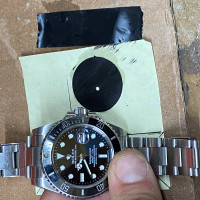Sold an ebike I made, have lots of play money. I have made some gilt decal dials but want to try to go one step further.
I recently had a 6538 template printed by a UV printer (see image below), it looks a bit grainy though from the preview photo. The printer says its just the way the light it hitting it and it looks very crisp otherwise. My next idea is to coat the brass dial then get it laser engraved, effectively removing the coating and exposing the brass dial. From reading, it appears that the black ink on the gilt dials isn't really ink but a coating (galvanic coating). Any idea what kind of coating went on the old Rolex gilt dials to get the black color?

I recently had a 6538 template printed by a UV printer (see image below), it looks a bit grainy though from the preview photo. The printer says its just the way the light it hitting it and it looks very crisp otherwise. My next idea is to coat the brass dial then get it laser engraved, effectively removing the coating and exposing the brass dial. From reading, it appears that the black ink on the gilt dials isn't really ink but a coating (galvanic coating). Any idea what kind of coating went on the old Rolex gilt dials to get the black color?

Last edited:


